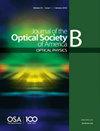Second harmonic enhancement effect in the double U split-ring resonators
IF 1.9
4区 物理与天体物理
Q3 OPTICS
Journal of The Optical Society of America B-optical Physics
Pub Date : 2023-10-10
DOI:10.1364/josab.497381
引用次数: 0
Abstract
Frequency multiplication plays an important role in spectrum research; therefore, in order to achieve enhancement of the second harmonic, the internal structure of nonlinear plasma metamaterial cells becomes more and more complex. The original harmonic oscillator model only regards the cell as a single harmonic oscillator, and a complete understanding of the physical processes involved in harmonic generation experiments in plasmonics is still lacking. In the case in which the plasma structure in a single cell becomes more and more complex, it is not reasonable to regard the entire cell as a single nonlinear oscillator. So expanding the harmonic oscillator model becomes more significant. In this paper, the internal structure of the proposed double U split-ring resonators (DU-SRRs) is regarded as two harmonic oscillators with different resonant frequencies, and the generation process of the enhanced second harmonic is explained by the resonance theorem. The second and third order nonlinear coefficients of the metamaterial are calculated, and the theoretical second harmonic conversion efficiency is obtained by using the second order nonlinear coefficients. Compared with the simulation results of the DU-SRR based on the split-ring resonator, we validate this classical theory as well as the associated numerical algorithm. The ability of the DU-SRR to enhance the second harmonic is proved, and the physical changes inside the cell and the reasons for the enhancement are explained in detail. This method can be used to analyze the nonlinear phenomena in metamaterials with complex cell structures.双U型分环谐振器的二次谐波增强效应
频率倍增在频谱研究中占有重要地位;因此,为了实现二次谐波的增强,非线性等离子体超材料电池的内部结构变得越来越复杂。原有的谐振子模型仅将细胞视为单个谐振子,对等离子体中谐波产生实验所涉及的物理过程仍缺乏完整的认识。当单个细胞内的等离子体结构变得越来越复杂时,将整个细胞视为单个非线性振荡器是不合理的。因此,扩展谐振子模型就显得尤为重要。本文将所提出的双U裂环谐振器(DU-SRRs)的内部结构视为两个谐振频率不同的谐振子,并用共振定理解释了增强二次谐波的产生过程。计算了超材料的二阶和三阶非线性系数,并利用二阶非线性系数计算了理论二次谐波转换效率。通过与基于劈环谐振器的DU-SRR的仿真结果对比,验证了这一经典理论以及相关的数值算法。证明了DU-SRR增强二次谐波的能力,并详细说明了电池内部的物理变化和增强的原因。该方法可用于分析具有复杂胞结构的超材料中的非线性现象。
本文章由计算机程序翻译,如有差异,请以英文原文为准。
求助全文
约1分钟内获得全文
求助全文
来源期刊
CiteScore
4.00
自引率
5.30%
发文量
374
审稿时长
2.1 months
期刊介绍:
The Journal of the Optical Society of America B (JOSA B) is a general optics research journal that complements JOSA A. It emphasizes scientific research on the fundamentals of the interaction of light with matter such as quantum optics, nonlinear optics, and laser physics. Topics include:
Advanced Instrumentation and Measurements
Fiber Optics and Fiber Lasers
Lasers and Other Light Sources from THz to XUV
Light-Induced Phenomena
Nonlinear and High Field Optics
Optical Materials
Optics Modes and Structured Light
Optomechanics
Metamaterials
Nanomaterials
Photonics and Semiconductor Optics
Physical Optics
Plasmonics
Quantum Optics and Entanglement
Quantum Key Distribution
Spectroscopy and Atomic or Molecular Optics
Superresolution and Advanced Imaging
Surface Optics
Ultrafast Optical Phenomena
Wave Guiding and Optical Confinement
JOSA B considers original research articles, feature issue contributions, invited reviews and tutorials, and comments on published articles.

 求助内容:
求助内容: 应助结果提醒方式:
应助结果提醒方式:


